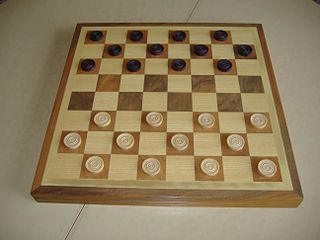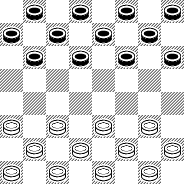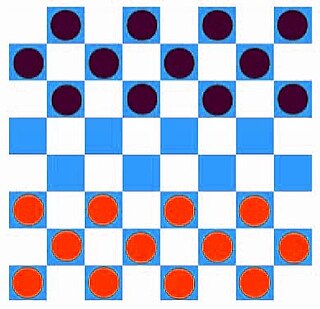
Hexdame (or HexDame) is a strategy board game for two players invented by Christian Freeling in 1979. The game is a literal adaptation of the game international draughts (checkers or Dame [note 1] ) to a hexagonal gameboard.

Hexdame (or HexDame) is a strategy board game for two players invented by Christian Freeling in 1979. The game is a literal adaptation of the game international draughts (checkers or Dame [note 1] ) to a hexagonal gameboard.
The Hexdame board is a regular hexagon consisting of 61 cells, with each player having 16 men in the initial setup as shown. A man can move forward one step to an adjacent empty cell (three directions for moving), or can capture an enemy piece on an adjacent cell by jumping in the same line to the empty cell immediately beyond it (six directions for capturing). A king's movement and jumping are along rows of adjacent hex cells (six directions – two vertical and four oblique).
Other than the above, the rules for Hexdame can be taken directly from those for international draughts (checkers). For convenience, these have been summarized below. (Else see International draughts#Rules.)
Though Hexdame precisely mirrors the rules of international draughts, the hex board geometry introduces important differences in play dynamic:

Sternhalma, commonly known as Chinese checkers or Chinese chequers, is a strategy board game of German origin that can be played by two, three, four, or six people, playing individually or with partners. The game is a modern and simplified variation of the game Halma. "Complexity: requires no counting or spelling; even young children can play."

Checkers, also known as draughts, is a group of strategy board games for two players which involve diagonal moves of uniform game pieces and mandatory captures by jumping over opponent pieces. Checkers is developed from alquerque. The term "checkers" derives from the checkered board which the game is played on, whereas "draughts" derives from the verb "to draw" or "to move".

International draughts is a strategy board game for two players, one of the variants of draughts. The gameboard comprises 10×10 squares in alternating dark and light colours, of which only the 50 dark squares are used. Each player has 20 pieces, light for one player and dark for the other, at opposite sides of the board. In conventional diagrams, the board is displayed with the light pieces at the bottom; in this orientation, the lower-left corner square must be dark.
American Pool Checkers, also called "American Pool", is a variant of draughts, mainly played in the mid-Atlantic and Southeastern United States and in Puerto Rico.

Christian Freeling is a Dutch game designer and inventor of abstract strategy games, notably Dameo, Grand Chess, Havannah, and Hexdame.

English draughts or checkers, also called straight checkers or simply draughts, is a form of the strategy board game checkers. It is played on an 8×8 checkerboard with 12 pieces per side. The pieces move and capture diagonally forward, until they reach the opposite end of the board, when they are crowned and can thereafter move and capture both backward and forward.

Turkish draughts (Armenian: շաշկի)(Arabic: دامە)(Kurmanji: دامە) is a variant of draughts (checkers) played in Turkey, Greece, Egypt, Kuwait, Lebanon, Syria, Jordan and several other locations around the Mediterranean Sea and Middle East.

Russian draughts is a variant of draughts (checkers) played in Russia and some parts of the former USSR, as well as parts of Eastern Europe and Israel.

Armenian draughts, or Tama, is a variant of draughts played in Armenia. The rules are similar to Dama. Armenian draughts, however, allows for diagonal movement.

Emergo is an abstract strategy game created by Christian Freeling and Ed van Zon in 1986. It belongs to the "stacking" category of games, or column checkers, along with Bashni and Lasca. The name comes from the motto of the Dutch province of Zeeland: Luctor et emergo meaning: "I wrestle and emerge". The goal of the game is to capture all of the opponents pieces similar to checkers/draughts. Emergo, and all column checkers, differ from most draughts variants because of their unique method of capture. A opponent's piece is added to the capturing player's column rather than being removed. Men can be recaptured from an opponent later on in the game.
Czech draughts is a board game played in the territory formerly occupied by Czechoslovakia. It is governed by the Czech Draughts Federation.

Italian draughts is a variant of the draughts family played mainly in Italy and Northern Africa. It is a two-handed game played on a board consisting of sixty-four squares, thirty-two white and thirty-two black. There are twenty-four pieces: twelve white and twelve black. The board is placed so that the rightmost square on both sides of the board is black.

Dameo is an abstract strategy board game for two players invented by Christian Freeling in 2000. It is a variant of the game draughts and is played on an 8×8 checkered gameboard.

Brazilian draughts is a variant of the strategy board game draughts. Brazilian Checkers follows the same rules and conventions as International draughts, the only differences are the smaller gameboard, and fewer checkers per player.

Poddavki, also known as Giveaway checkers, Suicide checkers, Anti-checkers or Losing draughts is a draughts (checkers) game based on the rules of Russian draughts, with the variation that a player wins if they have no legal moves on their turn, either by giving up all their pieces or having them all blocked. As in most varieties of draughts, capturing is mandatory. The game is played in Russia and some parts of the former Soviet Union.

Bashni, also known as column draughts, multi-level checkers, and rarer Chinese checkers, is a variation of draughts, known in Russia since the 19th century. The game is played according to the basic rules of Russian draughts, with the main difference being that draughts being jumped over are not removed from the playing field but are instead placed under the jumping piece . The resulting towers move across the board as one piece, obeying the status of the upper draught. When a tower is jumped over, only the upper draught is removed from it. If, as a result of the combat, the top draught changes colour, ownership of the tower passes on to the opposing player. Based on Bashni, but according to the basic rules of English draughts, world chess champion Emanuel Lasker developed the draughts game "Laska" and, in 1911, published its description. Lasker described towers that can only be "double-layered": i.e. there can be no alternation of colors. He also showed that during the game the number of game pieces either remains constant or decreases. Column draughts are a subject of interest for the mathematical Sciences: combinatorics, theory of paired zero-sum games, etc.

Tanzanian draughts is a unique variant of draughts (checkers) board game originally played in modern day Tanzania. This is the strategy game that is played by two people using pieces on board. The game is very similar to Czech draughts but in this type the player can capture using king or men, there is no priority for that. Apart from that they are completely similar in any way. The game is also somehow similar to American checkers and Shashki in case of starting position.

Malaysian checkers or Singaporean checkers, is a variant of the board game of draughts played primarily in Malaysia and Singapore, especially among the elder men. Similar to the Canadian checkers, it is played on a 12x12 checkered board. The game can also be played on a 8x8 board if a 12x12 board is unavailable. However, it is distinct from Checkers and Canadian Checkers in terms of its additional rules. Popular alternative names used locally for this game include Dum and Dam.
Frisian draughts is a variant of draughts native to Friesland in the Netherlands.The rules are similar to International draughts, but is notable for its unique feature of allowing for orthogonal captures in addition to the familiar diagonal capture of most draughts variants.